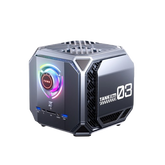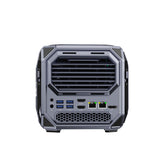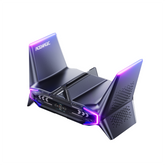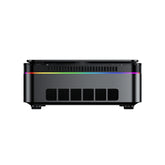From 8GB to 32GB: How Much RAM Is Enough for Your Laptop?
What is Random Access Memory (RAM) and Why Is It Important?
Random Access Memory (RAM) is your laptop’s short-term memory. It keeps the information your computer needs right now—like active apps, browser tabs, or files you’re working on—ready for instant use. When there’s enough RAM, your laptop runs smoothly because the processor can quickly retrieve data without waiting for the slower SSD or hard drive.
Think of RAM as your digital workspace. The more space you have, the easier it is to keep several programs open without slowing down. If RAM fills up, your system starts shifting active data to storage, which leads to lag when you switch between tasks.
RAM and storage serve different purposes: RAM handles temporary, fast-access data, while storage keeps your files permanently. That difference explains why two laptops with the same processor can perform very differently depending on their RAM size.
💡If you’d like to learn more about RAM in detail, check out our comprehensive guide: What Is RAM?
So, how much RAM do you need? The answer depends on how you use your laptop. The next section breaks down recommended RAM sizes for typical user profiles, helping you find the right balance between cost, speed, and workload.

How Much RAM Do You Need?
Choosing the right amount of RAM depends on your daily activities. A laptop with too little memory slows down during multitasking, while too much may not offer noticeable benefits for basic tasks. Below is a practical overview of how much RAM suits different usage levels—from casual users to professionals.
4GB–8GB: The Standard for Basic Users
If you mainly browse the web, check emails, or work on documents, 8GB of RAM is generally enough. It keeps everyday tasks responsive and stable for students or home users.
Who 8GB is for:
- Students working with Google Docs, spreadsheets, and basic software.
- Home users handle web browsing, streaming, or online shopping.
- Office tasks like email, calendar management, and light productivity apps.
Limitations of 8GB:
- Struggles with running many browser tabs simultaneously.
- It can lag during heavy multitasking, video calls, or large file processing.
- Less suitable for gaming or creative software such as Photoshop or Premiere Pro.
You need 8GB if:
- You use your laptop mainly for online work and media streaming.
- You prefer a budget-friendly laptop for light workloads.
- You don’t run memory-intensive software or virtual machines.
16GB: The “Sweet Spot” for Most Users
For most laptop owners today, 16GB offers the best balance between performance and cost. It handles multiple programs, dozens of browser tabs, and software like Photoshop or Zoom simultaneously without slowing down.
Who 16GB is for:
- Professionals using office suites, design tools, or light programming environments.
- Students in engineering, business, or media programs who use multitasking software.
- Moderate gamers play modern titles such as Valorant, Call of Duty, or Cyberpunk 2077.
Why 16GB is considered future-ready:
- Operating systems and applications continue to demand more memory.
- It provides smoother multitasking and extends laptop usability for several years.
- Allows you to switch between resource-heavy tasks like editing and browsing without performance loss.
32GB and Above: For Power Users and Professionals
If your work involves demanding applications, high-end gaming, or data processing, 32GB or more may be worth the investment.
Who 32GB+ is for:
- Video editors working with 4K or 8K footage.
- 3D designers and architects using modeling or rendering tools.
- Developers running virtual machines or large datasets.
- Streamers play high-resolution games while broadcasting.
|
RAM Size |
Best For |
Example Tasks |
|
8GB |
Light use |
Browsing, documents, and email |
|
16GB |
Balanced use |
Multitasking, creative work, gaming |
|
32GB+ |
Intensive use |
Video editing, 3D modeling, data analysis |
While 32GB might seem excessive for general users, professionals benefit from the additional headroom, especially when multitasking across large files or complex applications.

RAM Requirements for Specific Tasks
The right amount of RAM depends on how you use your laptop. Different activities rely on different memory levels. A system built for email and spreadsheets doesn’t need as much RAM as one for video editing or gaming. The sections below outline practical RAM guidelines for various tasks, helping you choose a configuration that matches your workload.
How Much RAM for Gaming
Games use RAM to load textures, environments, and background data that keep frame rates stable. The amount of memory you have directly affects how smoothly games run, especially when switching between applications like streaming tools or browsers.
8GB (Minimum for Older or Lightweight Games):
Works for older or less demanding titles such as Minecraft, Valorant, or League of Legends. These games load quickly and perform well at medium settings, but can struggle if background apps consume memory.
16GB (Adequate for Most Modern Games):
Provides a stable experience for current AAA games like Call of Duty: Warzone or Cyberpunk 2077, especially at low to medium settings. It covers the needs of most players but may reach its limit in high-resolution or ultra settings, where newer games allocate more data to RAM.
💡Want to know whether 16GB RAM is truly enough for gaming? Don’t miss our dedicated guide: Is 16GB RAM Enough for Gaming?
32GB (Recommended for High-Resolution and High-Frame-Rate Gaming):
Delivers consistent performance for 4K gaming, high-refresh-rate monitors, and multitasking while streaming or recording. This capacity prevents frame drops when games handle large textures, mods, or simultaneous background tasks.
In short, 16GB still covers the majority of gaming needs today, but 32GB offers better consistency for players targeting high visual quality, smooth frame rates, and long-term performance.
How Much RAM for Content Creation (Video and Photo Editing)
Creative software requires more RAM because it keeps multiple high-resolution assets active in memory. Editing large video files or working with layered images consumes gigabytes of temporary data.
16GB (Minimum requirements):
Enough for 1080p video editing or large Photoshop projects. You can edit comfortably while running browsers or light background apps.
32GB (Recommended for 4K Video and Complex Projects):
Provides smoother previews, faster rendering, and stable performance with tools like Adobe Premiere Pro, DaVinci Resolve, or Blender.
64GB or Higher (Professional Workflows):
Needed for 8K video editing, 3D rendering, or visual effects that handle massive file sizes and complex simulations.
|
Task Type |
Recommended RAM |
Example Software |
|
Basic Editing / Photography |
16GB |
Photoshop, Lightroom |
|
4K Video / 3D Modeling |
32GB |
Premiere Pro, Blender |
|
8K / Visual Effects |
64GB+ |
After Effects, DaVinci Resolve Studio |
How Much RAM for Students and Office Work
Students and office workers usually focus on multitasking between web browsers, productivity apps, and video conferencing tools.
8GB (Standard for Most Users):
Handles Word, Excel, Zoom, and research tasks comfortably. Ideal for writing reports, browsing, and managing online tools.
16GB (Recommended for Technical or Research Students):
Better for computer science, engineering, or design students who run code editors, simulations, or have dozens of browser tabs open simultaneously.
|
User Type |
Recommended RAM |
Example Workload |
|
General Students / Office Staff |
8GB |
Word, Excel, Chrome, Zoom |
|
Technical / Creative Students |
16GB |
MATLAB, AutoCAD, Visual Studio, multiple browsers |
Choosing the right RAM for your tasks keeps your laptop responsive under pressure. Once you identify your main use cases, matching the right RAM level prevents slowdowns and extends the lifespan of your device.
Checking and Upgrading RAM
Choosing the right amount of RAM is only part of the process. Knowing how to check your current memory and understanding whether you can upgrade it helps extend your laptop’s lifespan. Many laptops today offer limited upgrade options, so it’s useful to confirm these details before making a purchase or planning an upgrade.
How to Check Your Current RAM
You can quickly find out how much RAM your laptop has and how much is currently in use. Both Windows and macOS provide simple tools for this task.
For Windows 10 or 11:
- Press Ctrl + Shift + Esc to open Task Manager.
- Select the Performance tab.
- Click Memory on the sidebar.
- You’ll see total RAM capacity, current usage, and available slots if the system detects upgrade options.
For macOS:
- Click the Apple menu in the top-left corner.
- Select About This Mac.
- Under the Memory tab, check the total installed RAM and configuration details.
Monitoring RAM usage helps you decide when an upgrade might be necessary. If your memory usage often exceeds 80% while running standard applications, adding more RAM can significantly improve responsiveness.
Can You Upgrade Your Laptop RAM?
Not every laptop allows a memory upgrade. Modern ultrabooks and some MacBooks use soldered RAM, meaning the chips are permanently attached to the motherboard. Other laptops use SO-DIMM slots, where memory modules can be replaced or expanded.
If you’re unsure, check your laptop’s product page or manual. Most manufacturers specify whether memory is soldered or replaceable. For upgradeable systems, confirm the maximum supported RAM capacity and type (DDR4 or DDR5) before buying new modules.
Does RAM Speed (MHz, DDR4 vs. DDR5) Matter?
RAM speed influences how fast data moves between memory and the CPU. While a higher frequency (measured in MHz) can improve performance, the impact is smaller than upgrading capacity.
- DDR4 memory is common in most laptops released between 2017 and 2023. Typical speeds range from 2400MHz to 3200MHz.
- DDR5 memory, used in newer laptops, starts at 4800MHz and offers higher efficiency.
For most users, RAM size (the number of gigabytes) has a greater effect on performance than speed. Upgrading from 8GB to 16GB provides a more noticeable improvement than switching from DDR4 to DDR5 at similar capacities.
Having enough RAM ensures smooth multitasking, but understanding your laptop’s upgrade potential gives you flexibility for the future. Before upgrading, always verify compatibility to avoid mismatched modules or unsupported configurations.
FAQ
How much RAM is considered good for a laptop?
For most users, 16GB of RAM offers the best balance between performance and cost. It handles multitasking, modern applications, and moderate gaming without lag. Entry-level users can work with 8GB, while professionals dealing with design, video editing, or data analysis benefit from 32GB or higher.
Is it better to have more RAM or more GB?
This question often confuses two concepts: RAM (memory) and storage (capacity). RAM affects performance speed, while storage determines how much data you can save. More RAM improves multitasking and responsiveness, whereas more storage lets you keep larger files. Ideally, choose a setup with both adequate RAM (at least 16GB) and fast SSD storage (512GB or higher).
Is 8GB RAM enough for 5 years?
8GB is still usable in 2025 for basic tasks such as web browsing, document editing, and streaming. However, as operating systems and applications grow in memory demand, it may become restrictive within the next few years. For long-term reliability, 16GB offers better future coverage for software updates and heavier multitasking.
How much faster is RAM than SSD?
RAM operates at a much higher speed than SSD storage. Modern DDR4 RAM transfers data at around 25–35 GB/s, while a PCIe NVMe SSD reaches 3–7 GB/s under typical workloads. This means RAM can be roughly 5 to 10 times faster, which is why systems rely on RAM for active tasks rather than direct SSD access.
Does higher RAM mean a faster laptop?
More RAM allows your laptop to run several programs smoothly at once, but it doesn’t increase raw processing speed. Once your applications fit comfortably within available memory, adding more RAM provides limited improvement. However, if your system often runs near full memory usage, upgrading RAM can reduce lag and improve responsiveness significantly.
What is more important, RAM or storage?
Both are essential, but they serve different roles. RAM determines how efficiently your laptop handles active processes, while storage defines how much data you can keep. If your system feels slow when switching apps or multitasking, you likely need more RAM. If you’re running out of space for files and software, then more storage is the priority.
Conclusion
Understanding how much RAM you need helps you choose a laptop that fits both your current and future workload. RAM plays a direct role in how smoothly your system performs during daily tasks, creative work, or gaming.
If you want a laptop that handles daily tasks smoothly without overcomplicating things, the ACEMAGIC RX16 is a solid choice. With 16GB of memory, it easily manages office work, browsing, video calls, and light multitasking. Its reliable performance and sensible design make it perfect for students, professionals, or anyone looking for a dependable laptop that won’t break the bank.

ACEMAGIC RX16 AMD Ryzen™ 7 7735HS
The ACEMAGIC RX16 comes with an AMD Ryzen™ 7 7735HS processor and 16GB DDR5 RAM, delivering smooth multitasking and reliable performance for everyday work and entertainment. Its 16-inch 16:10 IPS display offers clear, comfortable viewing, while the 512GB NVMe SSD provides fast and ample storage.
For most people, 16GB remains the practical standard—it supports multitasking, modern software, and moderate gaming without slowdown. 8GB still works for web browsing or study use, while 32GB or more is ideal for professionals handling large projects or advanced creative software.
When deciding on upgrades, remember that RAM improves performance, and storage affects capacity. The right balance depends on what you do every day and how long you plan to keep your laptop. Checking whether your device allows upgrades before purchase can also extend its useful life.
Choosing RAM based on your real workload ensures that your laptop stays responsive for years without unnecessary upgrades. A well-matched configuration saves both time and cost while maintaining long-term performance stability.
Related Articles
- Do You Need 32GB of RAM? The RAM Guide Your PC Will Ever Need
-
LPDDR5 vs DDR5: Performance, Power Efficiency, and Key Differences
- Single Channel vs Dual Channel RAM: Understanding the Impact on Performance
- DDR4 vs DDR5 RAM: Comprehensive Comparison Guide
- DDR5 vs LPDDR5X: Speed, Gaming Performance & Which is Better








Leave a comment
Please note, comments need to be approved before they are published.